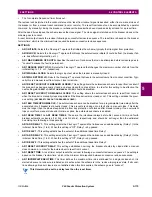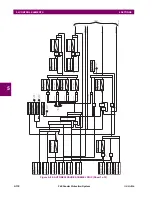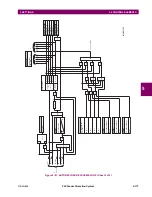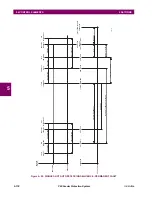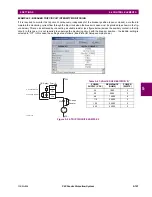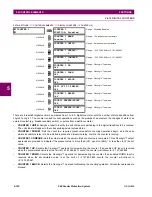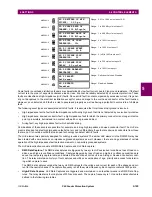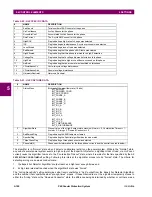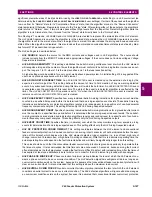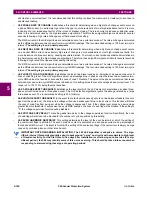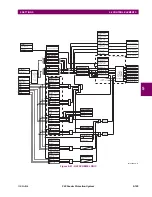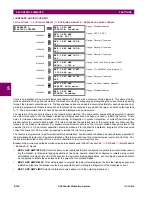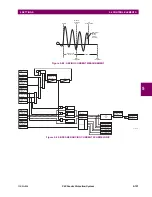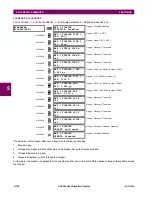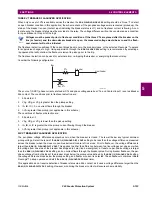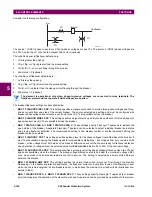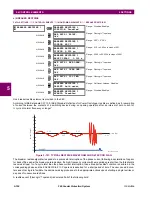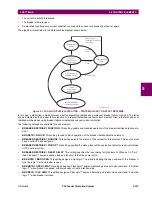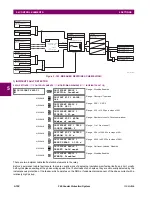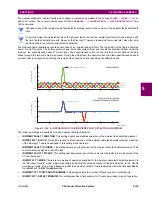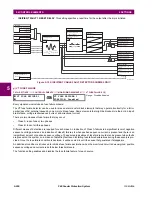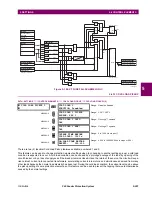
GE Multilin
F60 Feeder Protection System
5-187
5 SETTINGS
5.6 CONTROL ELEMENTS
5
significant, precipitous loss of load (as determined by the
LOSS OF LOAD THRESHOLD
user setting) or a Hi-Z overcurrent (as
determined by the
PHASE OC MIN PICKUP
and
NEUTRAL OC MIN PICKUP
user settings). If either of these caused the algorithm
to move from its “Normal” state to its “Coordination Timeout” state, then the algorithm moves to the “Downed Conductor”
state temporarily. Otherwise, it temporarily moves to the “Arcing” state. After pulsing either of these outputs, the algorithm's
state returns to “Normal”. Also, if two minutes pass without high levels from the Expert Arc Detector Algorithm while the
algorithm is in its Armed state, then it moves from the “Armed” state directly back to the “Normal” state.
Two FlexLogic™ operands,
HI-Z ARMED
and
HI-Z DISARMED
, are created to represent the armed state of the Hi-Z element.
The
HI-Z ARMED
operand is on when the algorithm is in the armed state, whereas the
HI-Z DISARMED
operand is on when
the algorithm is not in the armed state. When the algorithm is armed, this also includes the arcing and downed conductor
states. When the algorithm is disarmed, this also includes the normal and coordination timeout states (as defined by Mod-
bus format F187 as described in
Appendix B
).
The Hi-Z settings are described below:
•
HI-Z SOURCE
: Selects the source for the RMS currents and voltages used in Hi-Z algorithms. The source should
include currents from the 8F/8G CT module and appropriate voltages. If the source does not include voltages, Voltage
Supervision is disabled.
•
HI-Z ARCING SENSITIVITY
: This setting establishes the belief-in-arcing confidence level at which the Hi-Z element
will recognize arcing and the number of times the algorithm must conform its belief in arcing before it produces an out-
put. The range is 1 to 10, where 10 is the most sensitive and 1 is the least sensitive setting.
A higher setting would be suitable for a very quiet, well-behaved power system. An initial setting of 5 is suggested if the
user has no previous experience with the Hi-Z element.
•
HI-Z ARCING DET SOE RESET TIME
: An
ARCING DETECTED
event is created upon the detection of arcing by the
expert arc detector algorithm. This setting defines the amount of time to hold creation of any new arcing detected
events. Any subsequent arcing detection during this time will re-start the hold timer. An
ARCING DETECTED DPO
event
is generated upon the expiration of this reset time. The state of the expert arc detector algorithm is unaffected by this
timer. The
HI-Z ARC DETECTED DPO
operand is set to “On” when the
ARCING DETECTED DPO
event is created, and
remains on until an
ARCING DETECTED
event is created.
•
HI-Z PHASE EVENT COUNT
: Specifies how many individual belief-in-arcing indications for a phase current must be
counted in a specified time period before it is determined that an arcing-suspected event exists. These belief-in-arcing
indications are detected by arc detection algorithms (energy and randomness) for a specific set of non-fundamental
frequency component energies. This setting affects only the Hi-Z Arcing Suspected outputs.
•
HI-Z GROUND EVENT COUNT
: Specifies how many individual belief-in-arcing indications for a ground/neutral current
must be counted in a specified time period before it is determined that an arcing-suspected event exists. These belief-
in-arcing indications are detected by arc detection algorithms (energy and randomness) for a specific set of non-funda-
mental frequency component energies. This setting affects only the Hi-Z Arcing Suspected outputs.
•
HI-Z EVENT COUNT TIME
: Specifies the time (in minutes) over which the relay monitors long-term, sporadic, arcing
events for determination of an arcing-suspected event. This setting affects only the Hi-Z Arcing Suspected outputs.
•
HI-Z OC PROTECTION COORD TIMEOUT
: This setting coordinates between the Hi-Z element and conventional
feeder overcurrent protection. A downed conductor or an arcing, intact conductor will not be indicated before the expi-
ration of this timeout, which begins when the Hi-Z element detects a trigger condition (i.e. loss of load, high rate of
change, overcurrent, breaker open, or high belief-in-arcing confidence). Note that this is a minimum operating time; the
actual operating time will depend on the fault characteristics and will likely be significantly longer than this setting.
This value should be such that the conventional feeder overcurrent protection is given an opportunity to operate before
the timeout expires. It is recommended that this timeout value not exceed 30 seconds, because arcing fault current
often diminishes as the fault progresses, making the fault more difficult to detect with increasing time. After the timeout
has expired, at least one additional arc burst must occur in order for the Hi-Z element to proceed with its analysis.
•
HI-Z PHASE OC MIN PICKUP
: Phase overcurrent minimum pickup indicates the level at which the Hi-Z element con-
siders a phase current to be an overcurrent condition. The Hi-Z detection algorithms will ignore all data as long as an
overcurrent condition exists on the system, because it is assumed that conventional feeder overcurrent protection will
clear an overcurrent fault. It is recommended that this setting is above the maximum load current.
•
HI-Z NEUTRAL OC MIN PICKUP
: Neutral overcurrent minimum pickup indicates the level at which the Hi-Z element
considers a neutral current to be an overcurrent condition. The Hi-Z detection algorithms will ignore all data as long as
an overcurrent condition exists on the system, because it is assumed that conventional feeder overcurrent protection
Summary of Contents for F60 UR Series
Page 2: ......
Page 4: ......
Page 30: ...1 20 F60 Feeder Protection System GE Multilin 1 5 USING THE RELAY 1 GETTING STARTED 1 ...
Page 48: ...2 18 F60 Feeder Protection System GE Multilin 2 2 SPECIFICATIONS 2 PRODUCT DESCRIPTION 2 ...
Page 126: ...4 30 F60 Feeder Protection System GE Multilin 4 2 FACEPLATE INTERFACE 4 HUMAN INTERFACES 4 ...
Page 354: ...5 228 F60 Feeder Protection System GE Multilin 5 9 TESTING 5 SETTINGS 5 ...
Page 382: ...6 28 F60 Feeder Protection System GE Multilin 6 5 PRODUCT INFORMATION 6 ACTUAL VALUES 6 ...
Page 398: ...8 8 F60 Feeder Protection System GE Multilin 8 2 FAULT LOCATOR 8 THEORY OF OPERATION 8 ...
Page 414: ...A 14 F60 Feeder Protection System GE Multilin A 1 PARAMETER LIST APPENDIXA A ...
Page 492: ...B 78 F60 Feeder Protection System GE Multilin B 4 MEMORY MAPPING APPENDIXB B ...
Page 530: ...D 10 F60 Feeder Protection System GE Multilin D 1 IEC 60870 5 104 APPENDIXD D ...
Page 542: ...E 12 F60 Feeder Protection System GE Multilin E 2 DNP POINT LISTS APPENDIXE E ...
Page 558: ...x F60 Feeder Protection System GE Multilin INDEX ...



